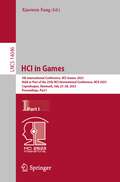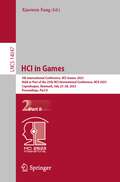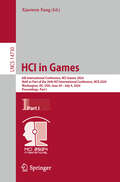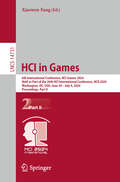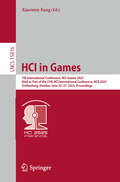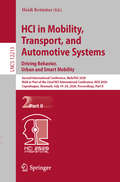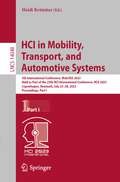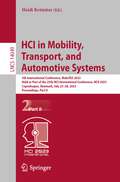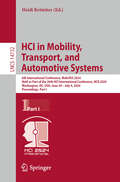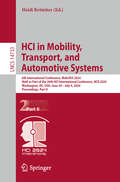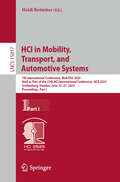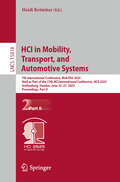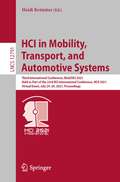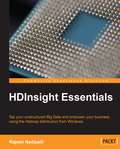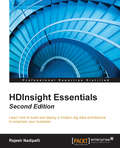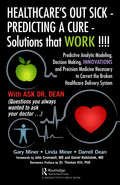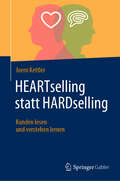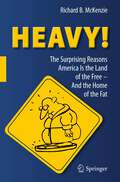- Table View
- List View
HCI in Games: 5th International Conference, HCI-Games 2023, Held as Part of the 25th HCI International Conference, HCII 2023, Copenhagen, Denmark, July 23–28, 2023, Proceedings Part I (Lecture Notes in Computer Science #14046)
by Xiaowen FangThis two-volume set of HCI-Games 2023, constitutes the refereed proceedings of the 5th International Conference on HCI in Games, held as Part of the 24th International Conference, HCI International 2023, which took place in July 2023 in Copenhagen, Denmark.The total of 1578 papers and 396 posters included in the HCII 2023 proceedings volumes was carefully reviewed and selected from 7472 submissions. The HCI in Games 2023 proceedings intends to help, promote and encourage research in this field by providing a forum for interaction and exchanges among researchers, academics, and practitioners in the fields of HCI and games. The Conference addresses HCI principles, methods and tools for better games.
HCI in Games: 5th International Conference, HCI-Games 2023, Held as Part of the 25th HCI International Conference, HCII 2023, Copenhagen, Denmark, July 23–28, 2023, Proceedings, Part II (Lecture Notes in Computer Science #14047)
by Xiaowen FangThis two-volume set of HCI-Games 2023, constitutes the refereed proceedings of the 5th International Conference on HCI in Games, held as Part of the 24th International Conference, HCI International 2023, which took place in July 2023 in Copenhagen, Denmark.The total of 1578 papers and 396 posters included in the HCII 2023 proceedings volumes was carefully reviewed and selected from 7472 submissions. The HCI in Games 2023 proceedings intends to help, promote and encourage research in this field by providing a forum for interaction and exchanges among researchers, academics, and practitioners in the fields of HCI and games. The Conference addresses HCI principles, methods and tools for better games.
HCI in Games: 6th International Conference, HCI-Games 2024, Held as Part of the 26th HCI International Conference, HCII 2024, Washington, DC, USA, June 29–July 4, 2024, Proceedings, Part I (Lecture Notes in Computer Science #14730)
by Xiaowen FangThis book constitutes the refereed proceedings of the 6th International Conference on HCI in Games, held as part of the 26th International Conference, HCI International 2024, which took place in Washington DC, USA, during June 29 - July 4, 2024. The total of 1271 papers and 309 posters included in the HCII 2024 proceedings was carefully reviewed and selected from 5108 submissions. The two volume set of HCI-Games 2024 proceedings were organized in the following topical sections: Volume 14730: Part I: Game Design and Gamification; Part II: Game-based Learning; Part III: Games and Artificial Intelligence Volume 14731: Part I: Advancing Education Through Serious Games; Part II: Player Experience and Engagement
HCI in Games: 6th International Conference, HCI-Games 2024, Held as Part of the 26th HCI International Conference, HCII 2024, Washington, DC, USA, June 29–July 4, 2024, Proceedings, Part II (Lecture Notes in Computer Science #14731)
by Xiaowen FangThis book constitutes the refereed proceedings of the 6th International Conference on HCI in Games, held as part of the 26th International Conference, HCI International 2024, which took place in Washington DC, USA, during June 29 - July 4, 2024. The total of 1271 papers and 309 posters included in the HCII 2024 proceedings was carefully reviewed and selected from 5108 submissions. The two volume set of HCI-Games 2024 proceedings were organized in the following topical sections: Volume 14730: Part I: Game Design and Gamification; Part II: Game-based Learning; Part III: Games and Artificial Intelligence. Volume 14731: Part I: Advancing Education Through Serious Games; Part II: Player Experience and Engagement.
HCI in Games: 7th International Conference, HCI-Games 2025, Held as Part of the 27th HCI International Conference, HCII 2025, Gothenburg, Sweden, June 22–27, 2025, Proceedings (Lecture Notes in Computer Science #15816)
by Xiaowen FangThis book constitutes the refereed proceedings of the 7th International Conference on HCI in Games, held as part of the 27th International Conference, HCI International 2025, which took place in Gothenburg, Sweden, during June 22–27, 2025. The total of 1430 papers and 355 posters included in the HCII 2025 proceedings was carefully reviewed and selected from thousands of submissions. The HCI-Games 2025 proceedings was organized in the following topical sections: Part 1: Gamification, UX, and Player BehaviorPart 2: Identity, Emotion, and AI in Game ExperiencesPart 3: Gamified Learning and DesignPart 4: Games in Healthcare and Wellbeing
HCI in Mobility, Transport, and Automotive Systems. Automated Driving and In-Vehicle Experience Design: Second International Conference, MobiTAS 2020, Held as Part of the 22nd HCI International Conference, HCII 2020, Copenhagen, Denmark, July 19–24, 2020, Proceedings, Part I (Lecture Notes in Computer Science #12212)
by Heidi KrömkerThis two-volume set LNCS 12212 and 12213 constitutes the refereed proceedings of the Second International Conference on HCI in Mobility, Transport, and Automotive Systems, MobiTAS 2020, held as part of the 22nd International Conference on Human-Computer Interaction, HCII 2020, in Copenhagen, Denmark, in July, 2020.* A total of 1439 full papers and 238 posters have been carefully reviewed and accepted for publication in HCII 2020. The papers cover the entire field of human-computer interaction, addressing major advances in knowledge and effective use of computers in a variety of application areas. MobiTAS 2020 includes a total of 59 papers and they are organized in the following topical sections: Part I, Automated Driving and In-Vehicle Experience Design: UX topics in automated driving, and designing in-vehicle experiences.Part II, Driving Behavior, Urban and Smart Mobility: studies on driving behavior, and urban and smart mobility. *The conference was held virtually due to the COVID-19 pandemic.
HCI in Mobility, Transport, and Automotive Systems. Driving Behavior, Urban and Smart Mobility: Second International Conference, MobiTAS 2020, Held as Part of the 22nd HCI International Conference, HCII 2020, Copenhagen, Denmark, July 19–24, 2020, Proceedings, Part II (Lecture Notes in Computer Science #12213)
by Heidi KrömkerThis two-volume set LNCS 12212 and 12213 constitutes the refereed proceedings of the Second International Conference on HCI in Mobility, Transport, and Automotive Systems, MobiTAS 2020, held as part of the 22nd International Conference on Human-Computer Interaction, HCII 2020, in Copenhagen, Denmark, in July, 2020.* A total of 1439 full papers and 238 posters have been carefully reviewed and accepted for publication in HCII 2020. The papers cover the entire field of human-computer interaction, addressing major advances in knowledge and effective use of computers in a variety of application areas. MobiTAS 2020 includes a total of 59 papers and they are organized in the following topical sections: Part I, Automated Driving and In-Vehicle Experience Design: UX topics in automated driving, and designing in-vehicle experiences.Part II, Driving Behavior, Urban and Smart Mobility: studies on driving behavior, and urban and smart mobility. *The conference was held virtually due to the COVID-19 pandemic.
HCI in Mobility, Transport, and Automotive Systems: 5th International Conference, MobiTAS 2023, Held as Part of the 25th HCI International Conference, HCII 2023, Copenhagen, Denmark, July 23–28, 2023, Proceedings, Part I (Lecture Notes in Computer Science #14048)
by Heidi KrömkerThis book constitutes the refereed proceedings of the 5th International Conference on HCI in Mobility, Transport, and Automotive Systems, MobiTAS 2023, held as part of the 25th International Conference, HCI International 2023, held in Copenhagen, Denmark, in July 2023. The total of 1578 papers and 396 posters included in the HCII 2022 proceedings was carefully reviewed and selected from 7472 submissions. The MobiTAS 2023 proceedings were organized in the following topical sections: Part I: Autonomous and Assisted Driving; Cooperative and Intelligent Transport Systems; Urban Mobility; and Sustainable Mobility. Part II: Driver Behavior and Performance; Designing Driver and Passenger User Experience; and Accessibility and Inclusive Mobility.
HCI in Mobility, Transport, and Automotive Systems: 5th International Conference, MobiTAS 2023, Held as Part of the 25th HCI International Conference, HCII 2023, Copenhagen, Denmark, July 23–28, 2023, Proceedings, Part II (Lecture Notes in Computer Science #14049)
by Heidi KrömkerThis book constitutes the refereed proceedings of the 5th International Conference on HCI in Mobility, Transport, and Automotive Systems, MobiTAS 2023, held as part of the 25th International Conference, HCI International 2023, held in Copenhagen, Denmark, in July 2023. The total of 1578 papers and 396 posters included in the HCII 2022 proceedings was carefully reviewed and selected from 7472 submissions. The MobiTAS 2023 proceedings were organized in the following topical sections: Part I: Autonomous and Assisted Driving; Cooperative and Intelligent Transport Systems; Urban Mobility; and Sustainable Mobility. Part II: Driver Behavior and Performance; Designing Driver and Passenger User Experience; and Accessibility and Inclusive Mobility.
HCI in Mobility, Transport, and Automotive Systems: 6th International Conference, MobiTAS 2024, Held as Part of the 26th HCI International Conference, HCII 2024, Washington, DC, USA, June 29–July 4, 2024, Proceedings, Part I (Lecture Notes in Computer Science #14732)
by Heidi KrömkerThis book constitutes the refereed proceedings of the 6th International Conference on HCI in Mobility, Transport, and Automotive Systems, MobiTAS 2024, held as part of the 26th HCI International Conference, HCII 2024, which took place in Washington, DC, USA, during June 29-July 4, 2024. The total of 1271 papers and 309 posters included in the HCII 2024 proceedings was carefully reviewed and selected from 5108 submissions. The MobiTAS 2024 proceedings were organized in the following topical sections: Part I: Driver behavior and safety; human factors in automated vehicles; Part II: Urban mobility and public transportation; user experience and inclusivity in MobiTAS.
HCI in Mobility, Transport, and Automotive Systems: 6th International Conference, MobiTAS 2024, Held as Part of the 26th HCI International Conference, HCII 2024, Washington, DC, USA, June 29–July 4, 2024, Proceedings, Part II (Lecture Notes in Computer Science #14733)
by Heidi KrömkerThis book constitutes the refereed proceedings of the 6th International Conference on HCI in Mobility, Transport, and Automotive Systems, MobiTAS 2024, held as part of the 26th HCI International Conference, HCII 2024, which took place in Washington, DC, USA, during June 29-July 4, 2024. The total of 1271 papers and 309 posters included in the HCII 2024 proceedings was carefully reviewed and selected from 5108 submissions. The MobiTAS 2024 proceedings were organized in the following topical sections: Part I: Driver behavior and safety; human factors in automated vehicles; Part II: Urban mobility and public transportation; user experience and inclusivity in MobiTAS.
HCI in Mobility, Transport, and Automotive Systems: 7th International Conference, MobiTAS 2025, Held as Part of the 27th HCI International Conference, HCII 2025, Gothenburg, Sweden, June 22–27, 2025, Proceedings, Part I (Lecture Notes in Computer Science #15817)
by Heidi KrömkerThis book constitutes the refereed proceedings of the 7th International Conference on HCI in Mobility, Transport, and Automotive Systems, MobiTAS 2025, held as part of the 27th HCI International Conference, HCII 2025, which took place in Gothenburg, Sweden, during June 22–27, 2025. A total of 1430 papers and 355 posters included in the HCII 2025 proceedings was carefully reviewed and selected from 7972 submissions. The MobiTAS 2025 proceedings were organized in the following topical sections- Human-Autonomous Vehicle Interaction and User Experience; User Interfaces and Interaction Methods for Mobility; Trust, Transparency, and Comfort in Automated Driving; Pedestrian Interaction and Road Safety in Automated Mobility.
HCI in Mobility, Transport, and Automotive Systems: 7th International Conference, MobiTAS 2025, Held as Part of the 27th HCI International Conference, HCII 2025, Gothenburg, Sweden, June 22–27, 2025, Proceedings, Part II (Lecture Notes in Computer Science #15818)
by Heidi KrömkerThis book constitutes the refereed proceedings of the 7th International Conference on HCI in Mobility, Transport, and Automotive Systems, MobiTAS 2025, held as part of the 27th HCI International Conference, HCII 2025, which took place in Gothenburg, Sweden, during June 22–27, 2025. The total of 1430 papers and 355 posters included in the HCII 2025 proceedings was carefully reviewed and selected from 7972 submissions. The MobiTAS 2025 proceedings were organized in the following topical sections- Human-Autonomous Vehicle Interaction and User Experience; User Interfaces and Interaction Methods for Mobility; Trust, Transparency, and Comfort in Automated Driving; Pedestrian Interaction and Road Safety in Automated Mobility.
HCI in Mobility, Transport, and Automotive Systems: Third International Conference, MobiTAS 2021, Held as Part of the 23rd HCI International Conference, HCII 2021, Virtual Event, July 24–29, 2021, Proceedings (Lecture Notes in Computer Science #12791)
by Heidi KrömkerThis book constitutes the proceedings of the Third International Conference on HCI in Mobility, Transport, and Automotive Systems, MobiTAS 2021, held as part of the 23rd International Conference, HCI International 2020, held as a virtual event, in July 2021.The total of 1276 papers and 241 posters included in the 36 HCII 2021 proceedings volumes was carefully reviewed and selected from 5222 submissions. MobiTAS 2021 includes a total of 39 regular papers which focus on topics related to urban mobility, cooperative and automated mobility, UX in intelligent transportation systems, and mobility for diverse target user groups.
HCL America
by Gary W. Loveman Jamie O'ConnellShows students how a custom software programming company takes advantage of differences between the United States and India in the cost of skilled labor (software engineers) to give its customers rare expertise and lower prices. Asks students to examine the company from its customers' point of view. HCL America offers customers three ways to purchase its services. The company can send its engineers to work on customers' premises on a temporary basis; do programming projects at its U.S. facilities, or send work to its "software factories" in India. A range of factors, including cost, determine which of these methods is best for a particular customer's project. Customers who send work to India often save 50% off the costs of doing the work in the United States. The decision point presents a potential customer, Sateesh Lele, who must decide whether to hire HCL America or a competitor, or use his own staff, for a particular project. If he hires HCL America, he must decide between three methods of work--on-site, in the United States, or in India.
HCL Technologies (A)
by Linda A. Hill Tarun Khanna Emily A. SteckerWhen Vineet Nayar became president of HCL Technologies, a global IT services business, in April 2005, he knew the company needed drastic change. Since its founding as a hardware company in the 1970s, HCL had grown into an enterprise with $3.7 billion in revenues and a market capitalization of $5.1 billion. The company had 41,000 employees in 11 countries, but it was ill-prepared for the increasingly competitive market. With the shift from hardware to software and services, HCL had slipped behind its Indian competitors and multinational companies. Details the first phase of the transformation Nayar led in hopes of rejuvenating the industry pioneer. The tagline for this phase was "Employee First, Customer Second."
HDCS 4386: Campaign Advertising Project
by Marcella NorwoodHDCS 4386 Campaign Advertising Project Custom Edition for University of Houston
HDInsight Essentials
by Rajesh NadipalliThis book is a fast-paced guide full of step-by-step instructions on how to build a multi-node Hadoop cluster on Windows servers.If you are a data architect or developer who wants to understand how to transform your data using open source software, such as MapReduce, Hive, Pig and JavaScript, and also leverage the Windows infrastructure; this book is perfect for you. It is also ideal if you are part of a team who is starting or planning a Hadoop implementation, and you want to understand the key components of Hadoop, and how HDInsight provides added value in administration and reporting.
HDInsight Essentials - Second Edition
by Rajesh NadipalliIf you want to discover one of the latest tools designed to produce stunning Big Data insights, this book features everything you need to get to grips with your data. Whether you are a data architect, developer, or a business strategist, HDInsight adds value in everything from development, administration, and reporting.
HEAD vs. LEAD: Disruptions Originating at the High- vs. Low-End of the Market
by Elie Ofek Olivier Toubia Didier ToubiaTwenty five years after it was initially proposed, Clay Christensen's theory of disruptive innovation continues to be a major reference for entrepreneurs, corporate innovators, and investors. However, the term "disruptive innovation" is often used in ways and contexts that are not consistent with Christensen's original theory, which argues for initially accessing the market from the low end. For example, there has been controversy as to whether a firm like Tesla, which clearly accessed the market by targeting high-end consumers, should be thought of as having "disruptive" potential. Should all disruptions start at the low-end of the market or from unserved segments who can't afford the incumbents' current solutions (a "new market" foothold in Christensen's terminology)? Is it possible for an innovation that will ultimately disrupt and displace incumbents to start off by serving high-end segments that are currently participating in the market and are willing to pay top dollar? In this note, using several examples, including the emerging market of cultivated meat, a distinction between High-End Access Disruptions (HEAD) and Christensen's original Low-End Access Disruptions (LEAD) is proposed. Both strategies support innovations that have the potential, at scale, to dominate incumbents, but that are not able to do so initially due to a "handicap," i.e., a product shortcoming that mainstream consumers aren't willing to accept. The exposition analyzes similarities and differences in the disruptive processes implied by these two strategies, and provides practical guidelines to help entrepreneurs, innovators and investors choose the approach that best fits their situation.
HEALTHCARE's OUT SICK - PREDICTING A CURE - Solutions that WORK !!!!: Predictive Analytic Modeling, Decision Making, INNOVATIONS and Precision Medicine Necessary to Correct the Broken Healthcare Delivery System
by Linda Miner Gary D. Miner Darrell L. DeanThe U.S. healthcare system is in "complete chaos-disarray." Medical costs have increased significantly over the past 6 years with 70% increase for deductibles and 24% or more for health insurance premiums. All the while, workers earnings have either not increased or if they did, the pay raises were for less than the increase in the cost of medical care. The situation is unsustainable and the public wants the system fixed. This book offers ways of fixing the problems in healthcare. HEALTHCARE's OUT SICK - PREDICTING A CURE - Solutions that WORK !!!! first defines the "healthcare in crisis" problem. Through real patient experiences, the book describes the difficulties of getting through the maze of complexity among the plethora of "silo providers" which make up the industry. The heart of the book provides readers with a comprehensive solution that can work, a disruption that is necessary to provide Americans the medical care they need without the US public and healthcare providers and payors going into bankruptcy, insolvency or closure. This book delves into digitized medicine, payor and provider reimbursement models, and value-based healthcare delivery. It also includes a philosophy or mode of thinking and operation for the solutions that are needed for diagnosis-effective, cost-effective, and time-efficient healthcare delivery, of which digitized medicine, value-based care, and payor reimbursement modes are just some of the factors. The authors propose that the real solution involves having the patient at the center of the issues and changing from an archaic gold standard way of thinking to a "Predictive Analytic thinking" where one gets at the real truth by doing "real science" that in the end becomes effective not only for the population but for the individual person. This all leads to real person-centered and person-directed medicine and healthcare delivery.
HEARTselling statt HARDselling: Kunden lesen und verstehen lernen
by Joern KettlerDieses Buch zeigt Ihnen den Weg auf, wie Sie ein überdurchschnittlich guter Verkäufer / eine überdurchschnittlich gute Verkäuferin werden. Der Schlüssel dazu ist, den Menschen hinter Ihrem Kunden und Ihrer Kundin zu sehen und zu verstehen. Denn Menschen kaufen bei Menschen!Der Beziehungsfaktor ist für den Erfolg von Verkaufsabschlüssen von größter Bedeutung. Dazu müssen Sie im Verkauf und im Vertrieb Menschen „lesen“ können. Sie müssen Ihr Gegenüber respektieren und ihm glaubhaft vermitteln, dass Sie als Verkäufer oder Verkäuferin wirklich vertrauenswürdig sind – kurzum: ein Herz für Ihre Kunden und Kundinnen haben. Was es dazu alles braucht und wie das im Verkaufsalltag umsetzbar ist, beschreibt Joern Kettler in diesem Buch. Er setzt sich kritisch mit dem Hardselling auseinander und zeigt, wie es anders und besser geht: mit HEARTselling. Er gibt Ihnen das notwendige Know-how, wie Sie ein von Ihren Kunden und Kundinnen (und Ihren Vorgesetzten) hochgeschätzter Verkaufsberater werden.Aus dem InhaltWarum kaufen Kunden nicht?Was wünschen sich Kunden von Verkäufern?Der erste Kontakt und der erste EindruckDie Macht der WorteVerhaltenspsychologie – vom Gehirn, über Sinneseindrücke, Mindsets, Erwartungen und VerhaltensmusterDie Sales-Signs – Kunden körpersprachlich lesenPersönlichkeitstypen – den Kunden verstehen lernenExkurs: Mehr verkaufen im Hotel- und GastgewerbeStruktur im Verkauf – von der Bedarfsanalyse über das Angebot bis zum AbschlussMit zahlreichen Praxis-Tipps und illustrierenden Fotos.
HEAVY!
by Richard B. MckenzieAmerica's emerging "fat war" threatens to pit a shrinking population of trim Americans against an expanding population of heavy Americans in raging policy debates over "fat taxes" and "fat bans." These "fat policies" would be designed to constrain what people eat and drink - and theoretically crimp the growth in Americans' waistlines and in the country's healthcare costs. Richard McKenzie's HEAVY! The Surprising Reasons America Is the Land of the Free--And the Home of the Fat offers new insight into the economic causes and consequences of America's dramatic weight gain over the past half century. It also uncovers the follies of seeking to remedy the country's weight problems with government intrusions into people's excess eating, arguing that controlling people's eating habits is fundamentally different from controlling people's smoking habits. McKenzie controversially links America's weight gain to a variety of causes: the growth in world trade freedom, the downfall of communism, the spread of free-market economics, the rise of women's liberation, the long-term fall in real minimum wage,and the rise of competitive markets on a global scale. In no small way - no, in a very BIG way - America is the "home of the fat" because it has been for so long the "land of the free." Americans' economic, if not political, freedoms, however, will come under siege as well-meaning groups of "anti-fat warriors" seek to impose their dietary, health, and healthcare values on everyone else. HEAVY! details the unheralded consequences of the country's weight gain, which include greater fuel consumption and emissions of greenhouse gases, reduced fuel efficiency of cars and planes, growth in health insurance costs and fewer insured Americans, reductions in the wages of heavy people, and required reinforcement of rescue equipment and hospital operating tables. McKenzie advocates a strong free-market solution to how America's weight problems should and should not be solved. For Americans to retain their cherished economic freedoms of choice, heavy people must be held fully responsible for their weight-related costs and not be allowed to shift blame for their weight to their genes or environment. Allowing heavy Americans to shift responsibility for their weight gain can only exacerbate the country's weight problems.
